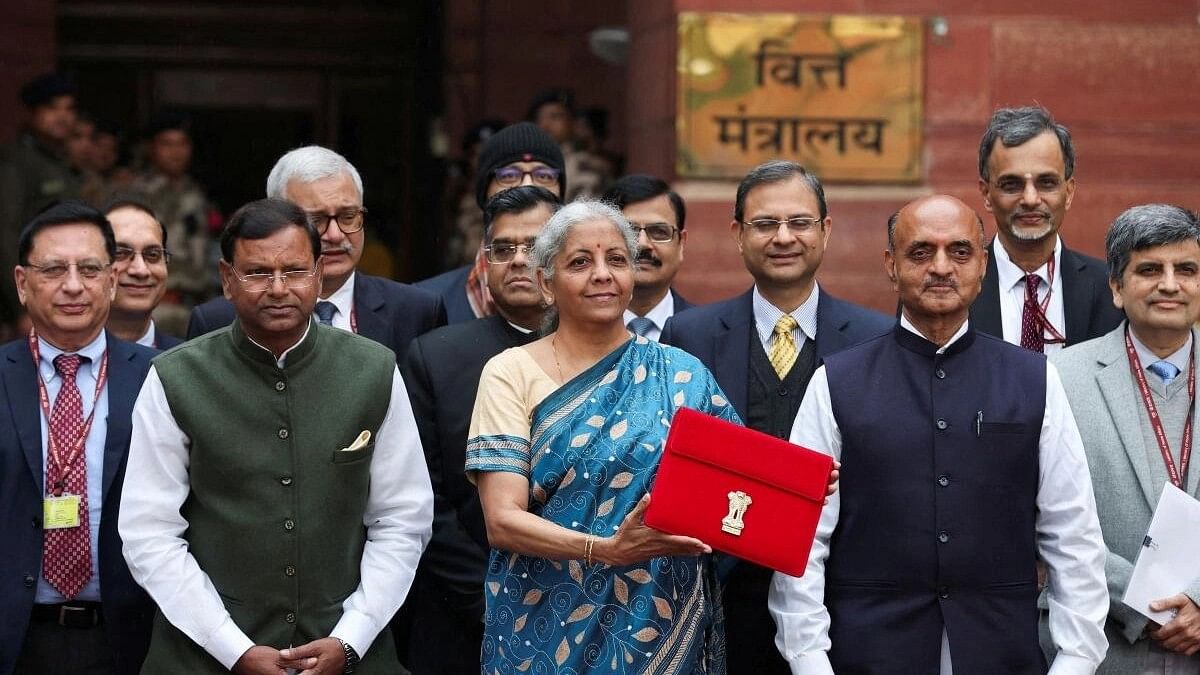
Nirmala Sitharaman and govt officials after the Budget speech.
Credit: PTI Photo
India’s 2024 Union Interim Budget highlights fiscal restraint alongside green energy and blue economy initiatives. A targeted fiscal deficit is below 5.1 per cent of GDP, with further reductions planned. However, to shrink the deficit, it limits subsidies for solar, wind, and biomass adoption and for coastal conservation. For example, the ‘rooftop solarization and muft bijli’ scheme is expected to save Rs 18,000 annually for one crore adopters, reducing approximately 23 MtCO2e in grid emissions. Notably, since the last budget, GHG emissions have increased by 8.2 per cent (320 MtCO2e), and the scheme saves no more than 7 per cent of these additional emissions. Despite the urgent need for greater initiatives, the budget’s emphasis on fiscal restraint limits government expenditures. The budget’s dual objectives of fiscal deficit reduction and mitigation incentives seem to be at odds.
A solution to this budget conundrum requires innovative approaches. A budgeting strategy employing carbon revenues is viable. The World Bank’s 2023 ‘State and Trends of Carbon Pricing’ reports that government revenues from carbon taxes and ETSs grew by over 10 per cent in 2022, reaching almost $95 billion globally. Direct carbon pricing, such as a carbon tax, is now seen as more than just a crucial mitigation policy; it is also regarded as a versatile tool for generating revenue. Especially in low- and middle-income countries, an emerging budget strategy is to use carbon pricing revenue to advance fiscal and decarbonisation goals. Aligning with this, substituting corporate tax on earnings with a carbon fee on emissions can eliminate resistance from industrial stakeholders. A carefully crafted green budget strategy can deliver a fiscal surplus while meeting decarbonisation objectives.
India’s current corporate tax receipts have reached Rs 9.2 lakh crore ($110 billion). What carbon price would be revenue-neutral? The starting point is current emissions, which for the industrial and energy sectors are about 3 GtCO2e. Therefore, a carbon tax of $37/tCO2e is revenue neutral in the swap. But this carbon tax is too low for the required trajectory to reach net zero.
Network of Central Banks and Supervisors for Greening the Financial System (NGFS) modelling recommends carbon prices of $69 by 2030 and $276 by 2050 for a below-2 degree C average global temperature rise above pre-industrial levels. IPCC modelling indicates significantly higher carbon prices for 1.5-degree C-equivalent scenarios. For social optimality, economists argue that the carbon tax rate should be set equal to the global social cost of carbon (SCC), currently nearing $200/tCO2e (the ADB reportedly uses the SCC in its project finance). It is a management imperative to make provisions for such carbon price scenarios. Clearly, transition risks are high; using the SCC carbon price in India results in over five times the carbon tax liability compared to corporate tax.
Thankfully, our advanced corporate finance system offers a perfect solution: converting annual tax liabilities at the SCC carbon tax to deferred taxes for long-term debt (see ‘Bridging business, policy for net-zero,’ DH, Jan 25). Budget analysts can then determine an annual carbon fee as the annual interest due on the debt instrument. This enables an annual interest on the debt, instead of an annual carbon tax, to be swapped with the corporate tax, resolving the excessive burden while providing the best incentives for decarbonisation. We could call this strategy “cap-and-swap.” From an industry stakeholder perspective, the swap replaces high transition risks with predictable fees. For the government, the swap can deliver a fiscal surplus and a socially optimal decarbonisation strategy. In every budget year, policymakers can rebalance corporate taxes and carbon fee interest rates, similar to adjustable-rate mortgages, to meet annual revenue objectives.
The basic infrastructure for swapping carbon fee revenue with corporate tax is established in India. Leading firms routinely update their decarbonisation ambition pathways and have them periodically validated by agencies like the Science-Based Target initiative (SBTi). Business Responsibility and Sustainability Reporting (BRSR) is already mandatory for the top 1,000 listed firms. Standardising both ambitions and disclosures for quantitative metrics across the entire industrial tax base is crucial, supported by expert agency guidance.
Tinbergen’s Rule asserts the necessity of an independent policy instrument for each objective. Cap-and-swap highlights the ability to incorporate two instruments: the carbon fee’s interest rate alongside the carbon tax rate (preferably at the SCC). This dual approach enables the budget to synergise both targeted carbon revenues and targeted decarbonisation incentives. By enabling government programmes with additional revenues, it not only grants cleaner industries a competitive edge but also motivates polluting industries to transition towards cleaner practices. In the context of the climate crisis, Union budgets must prioritise this strategy.
(The writer is a former faculty member at leading B-schools in India, Singapore, and the US)